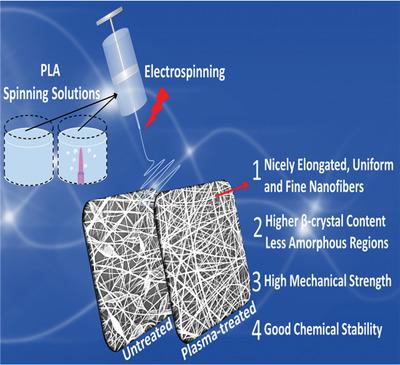当前位置:
X-MOL 学术
›
Macromol. Mater. Eng.
›
论文详情
Our official English website, www.x-mol.net, welcomes your feedback! (Note: you will need to create a separate account there.)
The Influence of Pre‐Electrospinning Plasma Treatment on Physicochemical Characteristics of PLA Nanofibers
Macromolecular Materials and Engineering ( IF 3.9 ) Pub Date : 2019-08-25 , DOI: 10.1002/mame.201900391 Fatemeh Rezaei 1 , Tom Planckaert 2 , Chris Vercruysse 3 , Jente Verjans 4 , Pascal Van Der Voort 2 , Heidi Declercq 3 , Richard Hoogenboom 4 , Rino Morent 1 , Nathalie De Geyter 1
Macromolecular Materials and Engineering ( IF 3.9 ) Pub Date : 2019-08-25 , DOI: 10.1002/mame.201900391 Fatemeh Rezaei 1 , Tom Planckaert 2 , Chris Vercruysse 3 , Jente Verjans 4 , Pascal Van Der Voort 2 , Heidi Declercq 3 , Richard Hoogenboom 4 , Rino Morent 1 , Nathalie De Geyter 1
Affiliation

|
Morphology, crystallinity, thermal, and mechanical properties of nanofibrous mats are known to highly affect the behavior of these materials in desired applications. In this study, multiple characteristics of poly(lactic acid) (PLA) nanofibrous mats prepared from plasma-treated pre-electrospinning solutions are studied as a function of various plasma operational parameters. X-ray diffraction, differential scanning calorimetry, thermogravimetric analysis, X-ray photoelectron spectroscopy, scanning electron microscopy, and tensile tests are performed. In addition, the pristine and plasma-treated PLA solutions are examined with size exclusion chromatography to study the effect of the conducted pre-electrospinning plasma treatments (PEPT) on the molecular weight of PLA. Aging analysis of the pristine and plasma-treated solutions is also performed by evaluating the viscosity, conductivity, surface tension, and pH during an aging period of 10 days. To investigate if the results are only affected by the plasma treatment or also affected by the electrospinning, pristine and plasma-treated PLA cast layers are also analyzed. The results reveal that PEPT preserved the surface chemical composition of the nanofibers and the molecular weight distribution of PLA, while morphology and mechanical properties of the nanofibers are considerably enhanced. Moreover, plasma-treated polymer solutions resulted in the formation of nicely elongated nanofibers up to 4 days after plasma treatment.
中文翻译:

预电纺等离子处理对PLA纳米纤维理化特性的影响
众所周知,纳米纤维垫的形态、结晶度、热和机械性能会极大地影响这些材料在所需应用中的行为。在这项研究中,研究了由等离子体处理的预静电纺丝溶液制备的聚乳酸 (PLA) 纳米纤维垫的多种特性,作为各种等离子体操作参数的函数。进行 X 射线衍射、差示扫描量热法、热重分析、X 射线光电子能谱、扫描电子显微镜和拉伸试验。此外,使用尺寸排阻色谱检查原始和等离子体处理的 PLA 溶液,以研究进行的预静电纺丝等离子体处理 (PEPT) 对 PLA 分子量的影响。原始溶液和等离子处理溶液的老化分析也通过评估粘度、电导率、表面张力和 10 天老化期间的 pH 值来进行。为了研究结果是否仅受等离子处理的影响或也受静电纺丝的影响,还分析了原始和等离子处理的 PLA 浇铸层。结果表明,PEPT 保留了纳米纤维的表面化学成分和 PLA 的分子量分布,同时显着增强了纳米纤维的形态和机械性能。此外,等离子体处理的聚合物溶液导致在等离子体处理后长达 4 天形成细长的纳米纤维。为了研究结果是否仅受等离子处理的影响或也受静电纺丝的影响,还分析了原始和等离子处理的 PLA 浇铸层。结果表明,PEPT 保留了纳米纤维的表面化学成分和 PLA 的分子量分布,同时显着增强了纳米纤维的形态和机械性能。此外,等离子体处理的聚合物溶液导致在等离子体处理后长达 4 天形成细长的纳米纤维。为了研究结果是否仅受等离子处理的影响或也受静电纺丝的影响,还分析了原始和等离子处理的 PLA 浇铸层。结果表明,PEPT 保留了纳米纤维的表面化学成分和 PLA 的分子量分布,同时显着增强了纳米纤维的形态和机械性能。此外,等离子体处理的聚合物溶液导致在等离子体处理后长达 4 天形成细长的纳米纤维。同时纳米纤维的形态和机械性能显着增强。此外,等离子体处理的聚合物溶液导致在等离子体处理后长达 4 天形成细长的纳米纤维。同时纳米纤维的形态和机械性能显着增强。此外,等离子体处理的聚合物溶液导致在等离子体处理后长达 4 天形成细长的纳米纤维。
更新日期:2019-08-25
中文翻译:

预电纺等离子处理对PLA纳米纤维理化特性的影响
众所周知,纳米纤维垫的形态、结晶度、热和机械性能会极大地影响这些材料在所需应用中的行为。在这项研究中,研究了由等离子体处理的预静电纺丝溶液制备的聚乳酸 (PLA) 纳米纤维垫的多种特性,作为各种等离子体操作参数的函数。进行 X 射线衍射、差示扫描量热法、热重分析、X 射线光电子能谱、扫描电子显微镜和拉伸试验。此外,使用尺寸排阻色谱检查原始和等离子体处理的 PLA 溶液,以研究进行的预静电纺丝等离子体处理 (PEPT) 对 PLA 分子量的影响。原始溶液和等离子处理溶液的老化分析也通过评估粘度、电导率、表面张力和 10 天老化期间的 pH 值来进行。为了研究结果是否仅受等离子处理的影响或也受静电纺丝的影响,还分析了原始和等离子处理的 PLA 浇铸层。结果表明,PEPT 保留了纳米纤维的表面化学成分和 PLA 的分子量分布,同时显着增强了纳米纤维的形态和机械性能。此外,等离子体处理的聚合物溶液导致在等离子体处理后长达 4 天形成细长的纳米纤维。为了研究结果是否仅受等离子处理的影响或也受静电纺丝的影响,还分析了原始和等离子处理的 PLA 浇铸层。结果表明,PEPT 保留了纳米纤维的表面化学成分和 PLA 的分子量分布,同时显着增强了纳米纤维的形态和机械性能。此外,等离子体处理的聚合物溶液导致在等离子体处理后长达 4 天形成细长的纳米纤维。为了研究结果是否仅受等离子处理的影响或也受静电纺丝的影响,还分析了原始和等离子处理的 PLA 浇铸层。结果表明,PEPT 保留了纳米纤维的表面化学成分和 PLA 的分子量分布,同时显着增强了纳米纤维的形态和机械性能。此外,等离子体处理的聚合物溶液导致在等离子体处理后长达 4 天形成细长的纳米纤维。同时纳米纤维的形态和机械性能显着增强。此外,等离子体处理的聚合物溶液导致在等离子体处理后长达 4 天形成细长的纳米纤维。同时纳米纤维的形态和机械性能显着增强。此外,等离子体处理的聚合物溶液导致在等离子体处理后长达 4 天形成细长的纳米纤维。

























 京公网安备 11010802027423号
京公网安备 11010802027423号